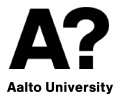A while ago I wrote about altmetrics and did some exercises with our publications. Time to lesson nr 2.
Now I wanted to try the ImpactStory JavaScript widget.
EDIT 19.12.2013: note that widgets will cease to work mid-January 2014. ImpactStory is concentrating in profiles
From every School, I took a sample (50) of articles that are the most cited according to Thomson Reuters WoS, and have a DOI. Saved in CSV, transformed first to XML, and then to HTML.
Adding the ImpactStory widget was easy, and it works as promised. Badges are unobtrusive yet informative. Nice little carriers of information. The more difficult part for me was to decide, how to arrange them on the page. What was it that I actually wanted to accomplish? Well, this time maybe not much more than a technical feasibility study.
I started with old skool HTML pages. Constructed a table element to each. Sorted articles by the number of WoS cites. Put the widget to the last cell.
The results are matter-of-fact but not very exciting, certainly not mobile. For example, here is the school of ARTS, and here SCI. Still, the rigid layout makes it easy to do quick comparisons. Some articles show similar behaviour in both traditional metrics and altmetrics: heavily cited, actively discussed or saved. On the other hand, there are also notable differences. From the Aalto University viewpoint, the School of Arts, Design and Architecture (ARTS) is particularly interesting. There is almost none hard (WoS) science with cited articles but more of that type of collaboration that seems to gather altmetrics.
For a more modern and mobile version, here is a transformation that gathers all Schools under the hood of one HTML5 page with the design help of the jQuery Mobile framework. Instead of tables, there are now lists. The ImpactStory badges look a little alone on the far right; maybe the ui-li-aside class is not a good choice here after all. Because of the tight position, also the text tends to hoover partly over the margin. Next time I will try how the badges look like in the middle of text paragraphs. Who knows, maybe they start a new flavour of punctuation marking of data.
Note that some articles are placed under multiple Schools, if they are work of collaboration. Due to my “ranking algorithm” – 50 most cited by WoS in that School – they may show up in one but not in the other(s). One such example is Stimulus-Related Independent Component and Voxel-Wise Analysis of Human Brain Activity during Free Viewing of a Feature Film which is near the top in ARTS but does not show up in SCI although the brain scientists from BECS (SCI) are equally involved.
One last word about the ARTS sample. There are only so many articles with WoS cites in the first place. The rest are randomly selected.

